ORIENTATION EDITION 25TH INFANTRY DIVISION, VIETNAM
Welcome to Tropic Lightning
The 25th Infantry Division
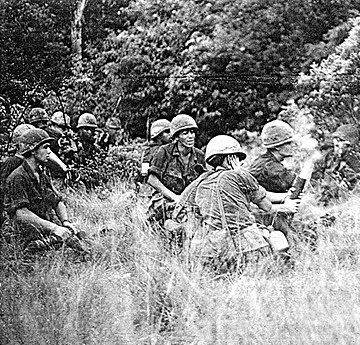
Page 2 TROPIC LIGHTNING NEWS Orientation Edition
Cu Chi - Less Than Paradise But Things Are
Improving
"Cu Chi, Cu Chi, worst place I ever did see," lament the lyrics of
a song written by a 25th Division Infantryman. But this lament was written in February,
1966, shortly after the 2d Brigade arrived at its then dusty and desolate new home.
Newsmen who visited the base camp early in that year now say they wouldn't
believe it's the same place. Roads that were once covered with choking foot-deep dust or
soft un-navigable mud—depending upon the time of day — are now paved and useable
in any weather.
The disorganized array of tents which were both quarters and offices have
given way to tent-kits, wooden hootches and customized steel quonset huts with cement slab
flooring. Nearly every military operation adds something to the base camp area when the
troops return. Often referred to as "company beautification" entire battalions
now have tree-lined roads, and small plants of various types.
Cleanliness may be next to Godliness, but at Cu Chi it is a reminder of
civilization that keeps morale high. The evolution of the shower in these two years since
the beginning of the camp, almost equals the development of the wheel by the cavemen.
Many varieties of showers exist, all serving their function. First came the
quartermaster power shower with a nearly unlimited supply of water from an adjacent well,
electrically pumped out of the ground. Eighteen to twenty bodies twisting under eight
showerheads constituted an overload however. Battalions went to work.
Airplane wing tanks were hoisted high in the air and several shower outlets
were connected on platforms below. Some units went so far as to pressurize tanks and to
build benches for the men to change clothes .
A lot has been done to improve that great morale factor, food. From meals of
C rations heated in GI cans and eaten on crude benches outdoors, the division has
progressed through tent-kit mess halls to modern half-brick screened in cement floored,
nearly monsoon-proof dining halls. Fresh A-rations are always reaching the troops.
As a last "way-back-then" tale, catching a chopper to Saigon or to
the field was once a matter of sitting on the chopper pad near where division artillery
headquarters is now, and running up to each ship as it landed, determining its destination
and trying to hitch a ride.
Now, however, progress and sophistication have set in. No longer do the 25th
Division soldiers have to homestead on the landing pad to get a ride. No longer is each
chopper pilot approached from all sides with requests for rides to all places. With a call
to the helipad, the weary soldier can be assured of a scheduled flight to his chosen
destination.
And this too, is progress.
 STANDING GUARD—The crew of an M-48 tank from the 3d Squadron 4th Cavalry stands guard through the night near Tan Son Nhut Air Base |
PADDY BREAK—Wearied soldiers of the 25th Division’s 1st Battalion 27th Infantry Wolfhounds take a break while waiting for helicopters to pick them off a rice paddy landing zone during an airmobile mission | 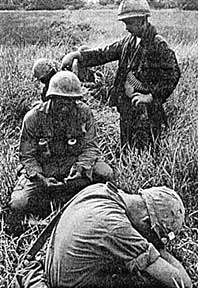 |
25th Div MEDCAP Another Battlefield
"Tropic Lightning Helping Hand" began in Hawaii before the 25th
Infantry Division was deployed to Vietnam. Knowing that civic action programs were a prime
factor in winning the war and the people's support, the division appealed to the citizens
of Hawaii for donations.
This was unique in one respect: most U.S. units deployed to Vietnam waited
until after they arrived in-country to solicit materiel to be given to the Vietnamese. The
25th Division felt it would be better to bring the charitable items with them, so that
civic action could start as soon as military action.
Hundreds of boxes containing tons of donated food, clothing, and articles of
sanitation eventually found their way to the Helping Hand Center, a small complex of
buildings and storage facilities at the Cu Chi base camp. There the donations were sorted,
so that gift packages are suited to the recipient.
From the Civil Affairs section, a handful of soldiers and Vietnamese workers
have built the storage areas and daily prepare dozens of boxes to be distributed by
infantry units while on MEDCAP (Medical Civic Action Program) or during military
operations.
In addition to material donations, men of the "Tropic Lightning division
have pitched in with a real helping hand, working on 293 health and sanitation projects,
71 construction projects, 44 education and training programs including the support of
Vietnamese schools and the teaching of English, as well as 265 other activities designed
to further Vietnamese-American relations and build support for the government of Vietnam.
The TROPIC LIGHTNING NEWS is an authorized publication of the 25th Infantry Division. It is published weekly for all division units in the Republic of Vietnam by the Information Office, 25th Infantry Division, APO San Francisco 96225. Army News Features, Army Photo Features, Armed Forces Press Service and Armed Forces News Bureau material are used. Views and opinions expressed are not necessarily those of the Department of the Army. Printed in Tokyo, Japan, by Pacific Stars and Stripes.
MG Ellis W. Williamson . . Commanding General
MAJ Andrew J. Sullivan . . Information Officer
2LT Don A. Eriksson . . . . Officer-in-Charge
SP4 Stephen Lochen . . . . . Editor
SP4 Tomm Quinn . . . . . . . . Assistant Editor
SP4 Bill Berger . . . . . . . . . . Production Supervisor
Taro Leaf With lightning Bolt Means Speed, Aggressiveness
The shoulder patch of the 25th Infantry Division was adopted late in 1943.
It is designed in the shape of a taro leaf, red, with a gold border, and a bolt of
lightning in gold, centered in the red leaf.
The taro leaf is reminiscent of the Hawaiian birth place of the 25th from
elements of the famous old Hawaiian Division, which had originally adopted the leaf for
its patch.
The taro plant has arrow-shaped leaves, often brilliantly colored and is
native to the Pacific Isles, though it is cultivated in many tropical and sub-tropical
areas. The rootstocks of the taro is a food, the flesh of which is similar to that of the
potato. It is used in the preparation of Poi, formerly a staple food product of Hawaii.
The slashing, golden, zig-zag bolt of lightning symbolizes speed and
aggressive spirit, and was superimposed upon the taro leaf to convey this additional
significance to the shoulder patch. This speed and aggressiveness was demonstrated by the
division when it struck back across the islands in the South-west Pacific in World War II
and against the communist forces in Korea.
After the Guadalcanal Campaign, the code word "Lightning" was
adopted, and all code words for the organic units of the division began with an
"L", which was difficult for the Japanese to pronounce. This aided in detecting
the enemy who tuned in on our radio frequency and answered our radio and telephone calls .
The division's nickname, the "Tropic Lightning" Division, is
re-echoed by the bolt of lightning on the shoulder patch. Although the nickname had been
carried by the division, unofficially, since December 1942, it was recognized as the
official title of the division on July 14, 1953.
Mission Of The Division
Search, Destroy, Support
The 25th Infantry Division will conduct search and destroy operations
against VC/NVA forces and base camps within the assigned tactical area of responsibility
and other areas as approved by Field Forces Vietnam II.
The Division will conduct clearing operations and reaction force operations
in support of the III Corps Revolution and Development Program with emphasis on the
National Priority areas in HAU NGHIA Province in coordination with CG, 25th ARVN Division;
and through him, the HAU NGHIA Province Chief.
Additionally, the 25th Infantry Division will provide support through ground
combat, artillery support, air support, civic action, psychological operations, and
limited training to the Regional and Popular Forces if necessary within the Division's
tactical area of responsibility.
There are several inferred missions that are included in this statement. It
is clear that we are expected to conduct operations which range from civic actions to
sustained combat. The division must be capable of contributing to the overall pacification
program within the assigned sector.
Page 3 TROPIC LIGHTNING NEWS Orientation Edition
PROUD PAST—PROUD FUTURE
"At the final stroke of twelve last night a fine old soldierman
passed away. But in his place stepped up two lusty sons to take his place."
These words in the October 1, 1941, edition of The Honolulu Advertiser
signaled the conception of the US Army's brand new infantry division.
T h e editorial continued: "The Hawaiian Division is no more. The proud
organization that was stationed at Schofield Barracks has been inactivated. In its place
this morning are two new streamlined infantry divisions—The Twenty-Fourth and the
Twenty-Fifth.
In the 27 years which have elapsed since their conception, the Army's two new
divisions were to see long and honorable service in three wars — service which would,
indeed, reflect great honor on their predecessor.
In time the 24th Infantry (Victory) Division, would find its way to the
European Theater of Operations, the Taromen were not to return to Hawaiian shores. But the
25th Infantry Division was destined to make its name in the Pacific.
And the name Tropic Lightning was not long in the making.
On December 7, 1941, just 10 weeks after the division's births Japanese
fighter-bombers roared through Hawaii's Kolekole Pass to bomb Pearl Harbor and strafe
Schofield Barracks. Division soldiers responded quickly to this unexpected attack,
becoming the first Americans to engage the enemy in World War II.
To counter the threat of a follow-up invasion, the 25th's infantrymen were
rapidly deployed to the beaches in defense of Honolulu and the Ewa Plains.
 For the next 11 months, the division trained intensively for a second crack at the enemy.
The scene was to be Guadalcanal.
For the next 11 months, the division trained intensively for a second crack at the enemy.
The scene was to be Guadalcanal.
Relieving the Marines at Guadalcanal in November 1942, division infantrymen
soon found themselves engulfed in the same treacherous jungle warfare which was to become
so painfully familiar to their Vietnam successors. In some of the bitterest World War II
fighting in the Pacific, the division aided in the seizure of Kokumbona and reduction of
the Mount Austin Pocket.
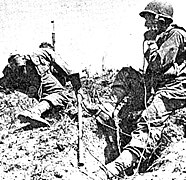 From there, division soldiers battled down the northern chain of Solomon Islands. The
island of New Georgia fell to them on August 25, 1943, they cleared Arundel Island on
September 24 and finally on October 6 they took Kolombangara, with its vital Vila Airport.
From there, division soldiers battled down the northern chain of Solomon Islands. The
island of New Georgia fell to them on August 25, 1943, they cleared Arundel Island on
September 24 and finally on October 6 they took Kolombangara, with its vital Vila Airport.
F o r their swiftness and daring during these campaigns, 25th Division
combat-hardened soldiers earned for their unit the nickname Tropic Lightning.
From January to June 1945 division soldiers participated in the liberation of
the Philippines, setting a record for Army divisions of 165 consecutive days in combat.
As the World War came to a close, the Tropic Lightning Division buckled down
to the job of occupying a defeated nation —the once mighty Empire of Japan.
The responsibilities of processing thousands of homeless refugees was an
immense burden. Indicative of the Tropic Lightning soldiers' devotion to this task was the
manner in which the 27th Infantry Wolfhounds and 8th Artillery commenced support to the
Holy Family Orphanage in Osaka, Japan, which has continued to this day.
 Since that November in 1949, over $400,000 has been donated to the orphanage, now known as
the "Osaka Home."
Since that November in 1949, over $400,000 has been donated to the orphanage, now known as
the "Osaka Home."
Still garrisoned in Japan in 1950, the division was again ordered to combat
as the North Korean "People's Army" stormed across the 38th Parallel, in an
unprovoked attack of the Republic of Korea.
While most Americans were trying to find Korea on the map, Tropic Lightning
soldiers, with other United Nations forces, raced to the defense of the port city of Pusan
on Korea's southern tip. The Pusan Perimeter held in large part due to the heroics of 25th
Division infantrymen, and soon (September 1950) Lightning soldiers were back on the
offensive, doing their part to neutralize the 50,000 North Koreans trapped as a result of
the Marine landings at Inchon.
For their role at Pusan, Tropic Lightning soldiers earned their first Korea
Presidential Unit Citation.
Battling seasoned North Korea and Chinese Communist soldiers and the harsh
extremes of Korean weather and terrain, division troops fought bravely and well from the
Yalu River in the north to the Han River in the south during the next two years.
Even during brief respites from battle as IX Corps' reserve force, the 25th
Division proved itself worthy of its motto, "Ready to Strike — Anywhere,
Anytime." In the words of one corps commander, "Today, the 25th Division is like
a razor's edge."
Back on the line to defend the South Korean capitol of Seoul, in May, 1953,
Tropic Lightning soldiers successfully repelled a fierce final assault by the enemy and in
doing so, earned their second Korean Presidential Unit Citation .
By the time the smoke of Korean battles had cleared, 14 Tropic Lightning
soldiers had earned their nation's highest military honor, the Medal of Honor.
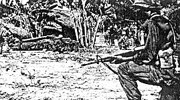 Following the July 27, 1953, armistice, the division was again tapped to perform
occupation duties and was not to depart Korea for over a year — but this time, after
more than 12 years absence the division was going home!
Following the July 27, 1953, armistice, the division was again tapped to perform
occupation duties and was not to depart Korea for over a year — but this time, after
more than 12 years absence the division was going home!
The first 25th Infantry Division troops arrived in Honolulu on September 21,
1954, aboard the troop ship USNS General Gordon. Bands, hula girls, and 25,000 orchids
dropped from helicopters, attested to the admiration of Hawaii's citizenry for their
battle-seasoned heroes.
Years of arduous training and realistic exercises followed as the division
filled its role as the Army's immediate strike force in the Pacific. Tropic Lightning
soldiers busied themselves by honing the "razor's edge."
The peaceful years came and went!
In early 1963 responding to a request from the US Military Assistance
Command, Vietnam, the first contingent of 100 aerial door gunners was dispatched to
Southeast Asia from Hawaii to relieve overworked helicopter crew members, who had been
forced to do double duty. By the time the program ended in November 1965, more than 2,200
men had participated.
Besides supplying shotgunners to Vietnam, the Tropic Lightning Division sent
Company C, 65th Engineer Battalion, to Vietnam in August, 1965, to act as a mobile force
to assist in the buildup of facilities at Cam Ranh Bay. It was the only unit from the
division in-country until late 1965.
MACV sent out a request for additional combat units in December 1965 and once
again the 25th Infantry Division responded, this time with its 4,000-man 3d Brigade.
Operation Blue Light, the longest and largest airlift of cargo and personnel to a combat
area in military history, took the brigade from Hawaii's Hickam Air Force Base to the
Central highlands at Pleiku.
The first Tropic Lightning soldiers arrived on December 31, 1965, and by the
middle of January, the 6,000-mile move of hundreds of tons of men and materiel was
completed.
Meanwhile, the division's 2nd Brigade had left Hawaii by sea. Arriving at the
port of Vung Tau on January 15, 1966, the brigade moved by air, first to Bien Hoa and then
in a convoy of more than 600 vehicles, to the former Viet Cong haven of Cu Chi in Hau
Nghia Province, 20 miles northwest of Saigon.
In late March 1966, the command group, composed of the commanding general and
his staff, was airlifted to Cu Chi and the 1st Brigade followed on Exercise
"Moonlight," arriving in-country by the end of April 1966. The division
deployment was complete.
 In jungles and tropic heat fighting a resourceful enemy who is barely distinguishable from
his surroundings, the men with the Lightning patch once again set about the business of
defending the Free World's frontiers.
In jungles and tropic heat fighting a resourceful enemy who is barely distinguishable from
his surroundings, the men with the Lightning patch once again set about the business of
defending the Free World's frontiers.
By mid July 1968, division soldiers had fought gallantly through 59
operations — each one a campaign of its own bearing names like Makiki, Kamela, Kailua
and Makalapa, which vividly illustrate the division's Hawaiian ties; each one taking
Tropic Lightning soldiers to treacherous battlefields with funny names like Hobo, Boi Loi,
Hoc Mon, Pleiku, Soui Cut, Cholon and Bao Trai.
In these 59 operations, more than 17,000 Viet Cong and North Vietnamese
soldiers have been felled by the combat power of Tropic Lightning infantrymen, cavalrymen,
and artillerymen. Nearly 900 more have been taken prisoner, and better than 4,600 have
surrendered to division troops under the Chieu Hoi Open Arms Program.
In a new kind of war for the hearts and minds of the Vietnamese people,
division soldiers have shown a genuine compassion and understanding for the problems
confronted by men and women who struggle to shake the enigma of war and to build a
brighter tomorrow.
An example of this compassion may be found in the more than 404,000
Vietnamese who have received medical attention during division MEDCAPS. Lightning soldiers
have also built houses, furnished food and clothing, secured polling places and taught
others to help themselves .
Another chapter in the saga of Tropic Lightning is being written. In a
hundred years it will be history. But today, Southeast Asia has a friend, a fighter, a
defender in the razor-sharp, Tropic Lightning 25th Infantry Division.
Page 4 TROPIC LIGHTNING NEWS Orientation Edition
Vietnam — Its Customs & Traditions
The customs and traditions practiced by the Vietnamese people, in whose country you are
a guest during your tour with the Free World Forces, may be traced back through many
centuries.
The people are courteous, patient, sensitive and quiet. To get along with
them well and to mix with them easily and courteously it is important to gain an
understanding of their way of life.
It is crucial that American servicemen cultivate an awareness of the
Vietnamese culture and appreciation of the aspirations of the people. Begin now!
Here are some of the does and don't when dealing with the people.
VIETNAMESE HOME
The Vietnamese regards his home differently than does a westerner. He
gives all the loyalty, concern, interest and respect to his home that Americans feel for
their community nation and entire earth.
His home is the focal point of his life. All other considerations are
secondary to the family and home. Yet he considers himself a furnishing in his home,
temporary and unimportant in the long run of time.
The Vietnamese code of behavior fosters courtesy, patience and kindness. Do
not mock it as it will negate the objectives of the assistance we are giving the people.
TABOOS FAMILIAR
Some of the taboos are familiar to readers of Emily Post or Dear Abby.
They include:
Do not put your feet on any part of the furniture; do not be, loud or overly
emotional in public (Vietnamese of opposite sexes will seldom hold hands in public): do
not ask about the price of personal possessions, do not shove your opinions or advice upon
others unless it is asked for; respect those older than yourself.
The Vietnamese practice these rules of etiquette much more than Americans and
regard violations seriously.
EXAMPLES CITED
Some taboos offend both the Vietnamese and his family, perhaps even his
ancestors.
Never pat anyone on the head and never cross your legs so that your feet
point toward anyone or to a shrine. These are based on the philosophy of humiliation and
veneration.
It is a good rule to avoid gregarious "convention" manners in
Vietnam. One should not offer to shake hands unless the Vietnamese does so first. Do not
be a back slapper.
Vietnamese people do not permit use of their first names lightly. Call each
by his rank or the proper form of the polite address. Incidentally, when writing a
Vietnamese name, spell it out in full.
BEWARE OF GESTURES
Gestures are a booby trap for Americans in Vietnam. Each gesture has so
many variations between our intent and a citizen's interpretation that trouble may arise
unwittingly. Save hand and arm signals for Americans only.
At the dining table, do not eat until the eldest present has started. Clean
your own plate but not the serving platter. If you repay hospitality, do not take him to a
"hamburger joint" even though the food may be better. Status is important.
The senior in age always picks the tab up.
If you send gifts to a Vietnamese, send them to the children if possible.
Never send an odd number. Two boxes of candy are much better than one.
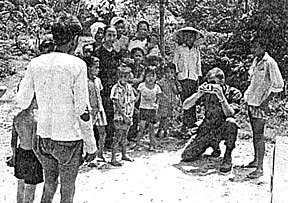 DIFFERENCES ENDLESS
DIFFERENCES ENDLESS
The number of differences goes on and on but the basic difference is one of
degree. The Vietnamese are much more formal and traditional, almost exaggerated, in
observing the amenities of life because they believe everything is integrated since the
beginning of time.
To break or mock these culture codes is to invite disgrace and disaster by
offending God, ancestors and nature.
If the American serviceman thinks before he speaks or acts, he will save
unnecessary grief. Common sense, courtesy and application of the Golden Rule will help him
steer clear of difficulties.
SMILE—First Lieutenant Alfred Saxe of San
Jose, California, Civil Affairs Officer for the 4th Battalion, 9th Infantry Manchus, takes
pictures of Vietnamese villagers while on a 1st Brigade civic action program near Hoc Mon.
A copy of the photo was given to each person, courtesy of the Manchus.
The Problems Of Enemy Detection
That Faceless Viet Cong
WHO ARE THE VIET CONG?
He is a farmer in a rice paddy, an old woman in the market place, a teenager
on a bicycle, a fisherman in a sampan. He is Vietnamese, indistinguishable from loyal
Vietnamese except by his actions.
He is also a tough fighter wherever he elects to fight.
The VC includes hard core political cadre, main force regular troops from the
south, local troops, part time guerrillas and men, women and children terrorized or
deluded into helping.
Whether he is a South Vietnamese trained in the north and then sent south, or
someone trained locally, the VC is told that he is fighting to liberate Vietnam from
Vietnamese traitors, from American "aggressors" and "imperialists" and
from colonialism.
VC ACCEPTS
PRIVATION
The average VC is a peasant, accustomed to privation and a
bare existence. He is subjected to continuous communist indoctrination and surveillance by
political cadre and fellow cell members .
Behind the VC is an organization controlled and supported from Hanoi with the
objective of subjugating all of Vietnam to the tyranny of communism.
All direction ultimately comes from the Central Committee of North Vietnam's
Lao Dong (communist) party. From its headquarters in Hanoi, the lines of control run to
committees and cells in South Vietnam's districts, villages and hamlets.
The Central Office, South Vietnam (COSVN), operating under Hanoi, is the
highest VC headquarters in the South. Under COSVN are six VC military regions directing
political and military actions.
BASIC ELEMENTS
Viet Cong forces, as separate from the North Vietnamese Army,
consist of the two basic elements of paramilitary and full military.
The paramilitary VC generally is a local civilian, a part-time soldier whose
duties do not take him far from home.
He may be used in village defense or to support regular forces in local
operations. He has little training, is armed with few and sometimes old model weapons and
usually wears the peasant's black pajamas.
These are forces which are generally identified as guerrillas. Like classic
guerrillas, they may live near their homes, appearing to be peasants by day but taking up
arms at night.
REGIONAL FORCES
Viet Cong regional forces are full-time soldiers but not
always uniformed. They rely mainly on guerrilla tactics and depend on the local area for
logistical support.
The elite troops are the VC main force battalions. They may wear uniforms
such as khaki shorts and shirts. The black pajamas are their fatigue uniforms.
Main force units are logistically supported from higher echelons, have better
weapons and conduct operations over a larger area.
NVA REGULARS
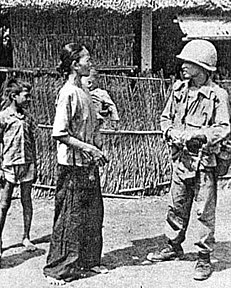 North Vietnamese Army units are regular forces,
distinctively uniformed. However, much of the distinction between VC and NVA units is
disappearing as VC units are reequipped and the NVA replaces its losses with VC fillers
and increases cadre strength in the VC main force units.
North Vietnamese Army units are regular forces,
distinctively uniformed. However, much of the distinction between VC and NVA units is
disappearing as VC units are reequipped and the NVA replaces its losses with VC fillers
and increases cadre strength in the VC main force units.
The Viet Cong use terror as a calculated weapon. Bombings, kidnappings,
assassinations, sabotage, harassing actions — all are planned and executed with the
goal of destroying government control and coercing people into cooperation with the VC.
VITAL DISTINCTION
It is vitally important to the U.S. serviceman to make the
distinction between the VC the loyal Vietnamese who make up the overwhelming majority of
the people.
Careless acts that hurt the people who are innocent civilians endanger the
support and loyalty of this group to the legal government and to our military effort.
NO VC HERE—A south Vietnamese interpreter
assigned to Company B, 2d Battalion, 14th Infantry, questions local population near
outskirts of Saigon during a recent sweep mission.
Page 5 TROPIC LIGHTNING NEWS Orientation Edition
Major Battalion Size Units -
Continued Page 12
| 7th Battalion
11th Artillery Nickname: None Motto: On Time Organized June 1, 1917 at Douglas, Arizona. Assigned to 25th Infantry Division April 1, 1960. Participated in 14 campaigns during World War I, World War II and Korean War. Has four battle streamers from World War II and Korean War. |
1st Battalion 8th
Artillery Nickname: Automatic Eighth Motto: Daring and Tenaciou Organized July 1916 at Fort Bliss, Texas. Assigned to the 25th Infantry Division October 1, 1941. Participated in 14 campaigns during World War I, World War II and Korean War. Has eight battle streamers form World War II and Korean War. |
65th Engineer
Battalion Nickname: Whiskey Fifth Motto: First In Last Out Organized October 1, 1941 and assigned to 25th Infantry Division. Has participated in 14 campaigns during World War II and Korean War, earning three battle streamers. |
||
| 25th Aviation Battalion Nickname: None Motto: We Fly For The Troops Organized February 1, 1957 and assigned to 25th Infantry Division. Has one battle streamer from the Vietnam War. |
725th Maint.
Battalion Nickname: None Motto: Service to the Line Organized October 1, 1941 in the territory of Hawaii. Assigned to the 25th Infantry Division November 1, 1942. Participated in 14 campaigns during World War II and Korean War, earning four battle streamers. |
25th S&T Battalion Niekname: None Motto: Without Delay Organized October 1, 1941 and assigned to the 25th Infantry Division. Participated in 14 campaigns during World War II and Korean War, earning six battle streamers. |
||
| 25th Medical
Battalion Nickname: None Motto: Medical Excellence Organized October 1, 1941 in the territory of Hawaii and assigned to the 25th Infantry Division. Participated in 14 campaigns during World War II and Korean War. Has four battle streamers from World War II and Korean War. |
125th Signal Battalion Nickname: None Motto: Leokani Okawuwila (Voice of Lightning) Organized October 1, 1941 in the territory of Hawaii and assigned to 25th Infantry Division. Has participated in 14 campaigns during World War II and Korean War, earning five battle streamers. |
HHB Divarty Nickname: Blaster Red & Yellow Motto: None Organized August 26, 1941 in the territory of Hawaii. Assigned to 25th Infantry Division October 1, 1941. Participated in four campaigns in World War II and ten campaigns in Korean War, earning three streamers. |
GI's Use Unique Vocabulary-What Did He Say?
The American soldier has always developed his own vocabulary to describe
the sights and sounds of war, and the soldiers of today are maintaining that tradition.
The jargon of the Vietnam GI is often humorous, sometimes confusing.
From the moment a replacement enters Vietnam he is subjected to the lingo of
war. The new man is a "turtle" for the man he replaces because he seems to be so
slow in arriving.
If he did not know before coming across the "big pond" (Pacific
Ocean), he soon learns that MACV stands for Military Assistanee Command, Vietnam; USARV
means United States Army, Vietnam; and "short-timer" is a soldier going home
soon.
A few of the terms for his fighting comrades, "jet jockey" and
"Saigon warrior," are self evident. Many are not. It is possible to spend
an entire tour of duty in Vietnam without learning all the terms for an infantryman. He is
a "grunt" or a "stump jumper." He is called a "gravel
crusher" or, most often, a "leg."
The enemy is called as many names as the infantryman, not all of them
printable. To a cocky replacement the "bad guys" are called "chuck" or
"Uncle Ho's boys."
After a few months in the "boondocks" the Gl respects the courage
of his tenacious foe and calls him "Mister Charles" or "Sir Charles."
A large bunker or tunnel complex is labeled "The Hanoi Hilton."
Enemy infested jungles become the "VC National Forests." A wounded
soldier is "zapped" by Charlie and enemy soldiers are "greased,"
"massaged," or "blown away," by "friendlies" (Allied
soldiers).
Abbreviations are used extensively in this war and it is possible to carry on
a conversation that would leave a linguist dizzy.
The military units of Vietnam are divided into several categories. The
"good-guys" are:
ARVN—Army of the Republic of Vietnam. This group is the Vietnamese regular army.
CIDG—Civilian Irregular Defense Group. A Vietnamese force that maintains territorial
border surveillance.
PF — Popular Forces. This force, recruited at local levels and kept in their home
villages, concerned with civil defense.
RF—Regional Forces. These troops maintain public order and security in rural areas.
Opposing the "good-guys" are members of the:
NVA — N o r t h Vietnamese Army. Trained and well equipped soldiers, the NVA have
taken over much of the fighting.
NLF—The National Liberation Front is the political organization of the Communist
forces.
VC—Viet Cong. This term, dating back to the French Indo-china War, refers to the
local guerrillas.
From the Vietnamese language the GI's have adopted "chop-chop"
for food, the French words "beau coup" for many, and "xin loi" for the
phrase "sorry 'bout that."
A snake is called "Mr. No-shoulders" and if a rumor going around Da
Nang can be believed the term "Sabre Jet" is fitting for the Vietnam mosquito.
A Marine swears that two mosquitoes landed at the big air base and a ground
crew had started refueling them before they realized their mistake and ran for a bunker.
Army and Air Force pilots have their own lingo for the various aircraft
employed in Vietnam.
When a pilot refers to his "Mattel Meschershmitt" he is talking
about the Cayuse. That high-speed helicopter, armed with a rapid firing machine gun, is
also called a "plexiglass play-toy" by pilots and ground troops alike.
The A-1E Skyraider, a prop driven World War II fighter-bomber, is
affectionately labeled "Spad."
The briefing room language of attack pilots that fly over the north include:
SAM—surface to air missile used by North Vietnamese against American aircraft.
Jinx— Means to take evasive zig-zag action to avoid SAM's.
Junk — what becomes of a million dollar war plane that zagged when it should have
zigged.
Beginning the day a "turtle" arrives, and until he leaves Vietnam as a "short-timer," the most important term in a GI's vocabulary encompasses everything from his sweetheart to Mom's apple pie and a soft bed: The United States — reverently called "The World."
RUSH FOR CHOPPERS—Men of Company C 3d Battalion 22nd Infantry climb aboard an eagle flight headed for the jungles near Nui Ba Den mountain. The soldiers jumped off from their night position at Fire Support Base Buell II four miles north of Tay Ninh.
Page 6 - 7 TROPIC LIGHTNING NEWS Orientation Edition
Welcome To The 25th Infantry Division
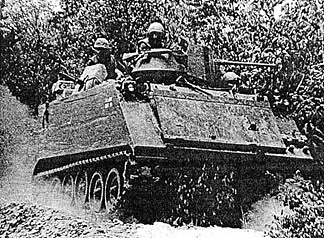 |
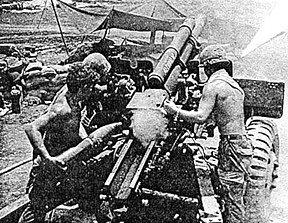 |
|
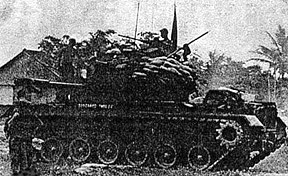 |
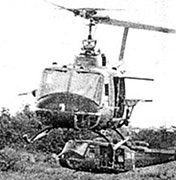 |
|
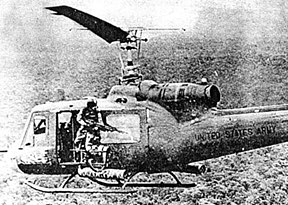 |
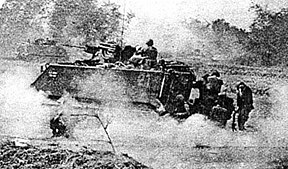 |
The Best Fighting Division Anywhere
Page 8 TROPIC LIGHTNING NEWS Orientation Edition
SERVICES: |
Special Information For Your Use Concerning Aide, Pay, Entertainment |
Most Popular Yell Ever -- 'Mail Call'
First class letter mail travels to and from Vietnam by air, with service
to most points of the United States averaging four to six days.
While stationed in Vietnam, you have free mailing privileges for air/first
class letter mail and sound recording tapes. Your complete return address and the
hand-written word "Free" (in lieu of postage stamps) should be placed on
outgoing mail to the United States, Puerto Rico and other possessions of the U.S. having
domestic mail service, including other Army, Navy or Air Force Post Offices. Do not write
"Free" on mail to foreign addresses. The APO will stamp "Post Paid" on
these items, so leave the upper right hand corner of the envelope blank.
You can also advise your correspondents that first class letter with normal
surface postage are usually sent to Vietnam by air on a space available basis. Parcel Post
packages weighing five pounds or less and measuring less than 60 inches length and girth
combined are moved by air on a space available basis between Vietnam and the west coast of
the United States. For packages between five and thirty pounds, and the same measurements,
they will go space available for the regular surface rate plus $1. Movement of other
parcel post is by surface unless the air mail rates are paid.
Personnel are cautioned that certain prohibited items such as flammables,
liquor, weapons, pornography and U.S. or foreign currencies are not permitted to be mailed
through postal channels.
Members of the Armed Forces stationed in Vietnam are entitled to a $50.00
customs exemption on bonafide gifts purchased in authorized facilities of the Armed
Forces. Special customs tags (POD Form 2966 or 2967) are available at the APO and must be
completed and affixed to all outgoing packages .
Three Army Post Offices serve the division with complete postal services,
including stamps and money orders. APO 96225 services the units at Cu Chi. APO 96385 is at
Tay Ninh and APO 96268 provides postal service for the men at Dau Tieng.
Your mail to you should be addressed as follows:
Rank, Name, Service NumberYour Unit
25th Infantry Division
APO San Francisco (APO of your base camp)
As soon as you know your unit and base camp it is recommended that you inform
all of your correspondents of your correct mailing address.
From Calling Home To More School
Call Home
You can call your family in the United States from the Cu Chi
Base Camp through the services provided by the Military Affiliated Radio System (MARS)
station, located in the 125th Signal Battalion area. Your call will go free to whichever
stateside MARS station is in radio contact. The stateside MARS station will place a long
distance collect call and you can talk for five minutes.
Post Exchanges
Well stocked post exchanges are located at all three base
camps. The exchanges stock essential Items, as well as gifts and civilian and military
clothing. Luxury Items and cigarettes are rationed, but the ration Is liberal and
adequate. Many items of personal comfort, such as fans, refrigerators, radios, television
sets, etc., are stocked and available In the exchanges. Electricity in the base camps is
110 volts, 60 cycles.
Legal Services
Legal assistance may be obtained in the office of the
Division Staff Judge Advocate, located at Division Headquarters at Cu Chi. A legal
assistance officer is available seven days a week during the day and no appointment is
necessary. Special appointments for unusual hours may be made by calling the office of the
SGA.
A legal assistance officer visits Tay Ninh and Dau Tieng base camps one day
each week. The hours of availability may be obtained from the 1st and 3rd Brigade
Headquarters.
Claims for lost or damaged household goods, hold baggage and property lost or
damaged in Vietnam may be filed at the office of the SJA.
Religious Services
Protestant and Roman Catholic Chaplains are available to all
25th Infantry Division personnel. The schedule of religious services (Roman Catholic
Protestant and Jewish) held at unit chapels is published weekly in the Division Daily
Bulletin. Chaplains are available at all times for the rites, sacraments and ordinaries of
the church as well as for religious instruction, counseling and help with personal
problems. Religious coverage is provided to isolated units and religious services are held
in the field during tactical operations.
Special Services
Recreational activities at the base camps are limited but
improving constantly Free 16-mm movies are available for showing at all division units.
Swimming pools are available to all personnel at Cu Chi and Dau Tieng.
The Ilikai East Service Club at Camp Cu Chi has pool tables, ping pong,
shuffle-board, volleyball, miniature golf and a quiet place to write letters or read
books. Refreshments may be purchased at Service Clubs maintained by most company and
battalion size units. Officer and NCO clubs are also maintained by many units. A division
EM Club is located across from division headquarters at Cu Chi.
Education Program
The Division Education Center, located In Camp Cu Chi, near
the Special Services Office, offers a limited number of accredited college courses, self
study IJSAFI courses and GED tests .
Money Matters Mean $ave
Federal Income Tax
Warrant officers and enlisted personnel have total relief
from payment of federal Income tax on their military pay and allowances received for any
month during any part of which the member served in Vietnam. Up to $500.00 per month of
such pay for commissioned officers is excluded from taxable wages.
Vietnamese Currency and Expenditures
The local currency is piasters (or dong). Denominations in
common usage are coins of 1, 5, and 10 piasters and paper currency of 5, 10, 20, 100, 200
and 500 piasters. The current military conversion rate is 118 piasters for one U.S. dollar
(MPC).
To curb inflation and stabilize the Vietnamese economy all personnel are
urged to hold piaster spending to a minimum. Each time piasters are purchased with U.S.
currency there is a drain on our nation’s gold reserve.
Uniformed Services Savings Deposit Program
As a result of increased income and reduced expenditures, most individuals
are able to accumulate considerable savings during their tour in Vietnam. The Uniformed
Services Savings Deposit Program pays participants ten percent interest annually,
compounded quarterly, on their savings while stationed overseas.
You may deposit any amount each month, in multiples of $5.00, not to exceed
the total pay received the previous pay day. Deposits made on or before the 10th
of the month accrue interest from the first of the month. Deposits made after the 10th
of the month accrue interest from the first of the next month. Personnel may participate
in this program by establishing a Class S allotment or by making cash deposits.
The Army Emergency Relief office is located in the Personnel Actions Division
of the Adjutant General Section (Building T-3585). The AER officer is available to discuss
your financial problems at any time.
Military Pay.
All personnel receive a significant increase in pay and allowances while
serving in Vietnam. In addition to your regular base pay, you are entitled to;
HOSTILE FIRE PAY. $65.00 per month payable for any part of any month spent in Vietnam.
FOREIGN DUTY PAY. Payable to enlisted personnel only. The amount varies according to pay grade.
BASIC ALLOWANCE FOR QUARTERS. Payable to all personnel whose dependents do not occupy adequate government quarters. The amount varies according to pay grade.
FAMILY SEPARATION ALLOWANCE (FSA-Type II). Payable to personnel qualifying for BAQ, or to a member with dependents who is in pay grade E-4 with over four years service, or higher. The monthly rate is $30.00.
BASIC ALLOWANCE FOR SUBSISTENCE. Payable to all officers and warrant officers at the rate of $47.88 per month.
How Long Is Your Tour?
The normal tour of duty In Vietnam is 12 months. Your date eligible for
return from overseas (DEROS) is normally one day prior to the anniversary date of your
departure from CONUS. Curtailment of a normal tour may be granted only in exceptional
cases where extreme personal hardship exists or to comply with a Department of the Army
directed reporting date to a new duty assignment.
Extension of the normal tour in Vietnam may be requested in any increments of
days or months up to 12 months at any one time. Personnel who extend for six or more
months are entitled to 30 days nonchargeable special leave plus travel time to any place
in the free world. Space required travel at Government expense is furnished individuals
authorized special leave.
Having Weapons
The carrying of privately owned weapons into Vietnam is prohibited. Individual weapons will be issued upon arrival at your unit of assignment. Weapons must be kept readily available at all times and carried whenever away from base camp. All weapons must be cleared while on base camp. Accidental discharge of firearms incidents are a matter of command concern. All the safety precautions you learned in basic still apply here in Vietnam.
See An Exotic Place On R&R
The Division Special Services Officer supervises the R&R program.
During the normal one year tour in Vietnam, all personnel are entitled to one
out-of-country R&R. Personnel who extend their foreign service tour for 91 days or
more are entitled to a second out-of-country R&R. Currently R&R Centers are
located in Honolulu, Hong Kong, Bangkok, Tokyo, Manila, Taipei, Singapore, Kuala Lumpur,
Penang and Sydney. The period of the R&R is five to seven days in the country visited
plus travel time.
In addition to the out-of-country R&R, enlisted personnel, warrant
officers and company grade commissioned officers may apply for a three day in-country
R&R to Vung Tau. The 25th Infantry Division has a standing allocation for 28 personnel
every three days.
In addition, all personnel may be authorized one out-of-country seven day
ordinary leave to any of the above R&R locations .
R&R or leave to the United States is not authorized except for Emergency
Leave, Compassionate Leave or Special Leave granted to personnel who extend their foreign
service tour in Vietnam for six months or more.
R&R and Special Leaves are not chargeable as leave on an Individual's
Leave Record.
Red Cross Aid
The American Red Cross provides service through its chapter supporting the
25th Infantry Division. You should notify your dependants that in case of any
emergency involving your immediate family, they should notify the nearest Red Cross
chapter or Field Director.
The facts needed to authorize emergency leave will be transmitted to the Red
Cross Field Director for the 25th Infantry Division. He will then notify you
and also confirm the facts to the commander having the authority to grant emergency leave.
Financial aid for emergency travel expenses is also provided by the Red Cross
if required. The local Field Director may also help in providing financial assistance to
military families through stateside Red Cross chapters.
Familiar sights in the 25th Division base camps are the Red Cross
"Doughnut Dollies," young women whose mission is to provide a recreational
program for the troops, no matter where they are located. The "Doughnut Dollies"
often go to the field to provide a relaxing break for 25th Infantry Division
soldiers.
Museum Of War
A worthwhile place to visit at Cu Chi Base Camp is the 25th Infantry
Division Museum. Located between the PX and the Ilikai East Service Club, it is open daily
from 8 a.m. until 11:30 a.m. and from 1 p.m. until 5 p.m.
On exhibit is the bounty of war — the captured weapons and materiel of
the Viet Cong and the North Vietnamese Army. Some of the equipment reflects other wars of
other times and other nations. For example, on display is a German 7.92 Light Machine Gun
Type 26 with a swastika on the stock. This weapon was first manufactured in 1926.
Also, of special interest are the Viet Cong tools of psychological warfare.
The museum has a wide selection of Viet Cong leaflets and posters.
Page 9 TROPIC LIGHTNING NEWS Orientation Edition
Medical Civic Action Fights Another War, Disease and Poverty
HELPING HAND — (Below, right) Specialist S
Emanual J. Holloman of Baltimore, Md. gives an alcohol bath to a Vietnamese child during a
25th Infantry Division medical civic action mission in Trang Bang
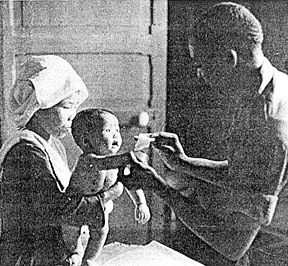 "MEDCAP'' is a term which has become part of the every-day language of the 25th
Division soldier. He uses the word as commonly as he talks about machine guns, grenade
launchers, Army food and when he's going home. And well he should, for
"MEDCAPs," or medical civic action programs, are just as much a part of the war
in Vietnam as any of these things.
"MEDCAP'' is a term which has become part of the every-day language of the 25th
Division soldier. He uses the word as commonly as he talks about machine guns, grenade
launchers, Army food and when he's going home. And well he should, for
"MEDCAPs," or medical civic action programs, are just as much a part of the war
in Vietnam as any of these things.
Since arriving at Cu Chi January 1966, medical teams from the Tropic
Lightning division have treated hundreds of thousands of Vietnamese citizens. Teams,
consisting of at least one Army doctor and several enlisted medics, spend part of the time
on each field operation "medcapping."
In addition, each division unit with its own medical staff has been assigned
a specific hamlet or village in the area near the base camp. Teams from the assigned unit
visit the village at least twice weekly, following a regular schedule This system, devised
by the division's Civil Affairs section, works best, claim the doctors, because it gives
them a chance to follow-up on treatment.
A whole gamut of illnesses and ailments has been treated by the MEDCAP teams.
Most common are: vitamin deficiency diseases, skin problems, respiratory disorders and
tooth and gum problems.
When not busy with soldier-patients, one or more of the division's 20
dentists may accompany the regular MEDCAP team. It is not uncommon for a dentist to pull
100 teeth in a four-hour visit to a nearby village. Vietnamese oral hygiene is very poor,
and the problem is compounded by betel nut chewing,
Vietnamese army interpreters accompany each team to the field, filling the
gap between doctor and patient, while at the same time strengthening the villager's
support for the government of Vietnam.
With more and more emphasis being placed on civic action, such as MEDCAP,
25th Infantry Division teams have increased their activity.
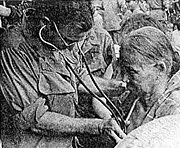 |
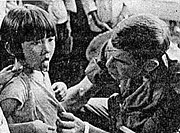 |
|
| BREATHE DEEP — An old women’s heart is checked by Captain Richard A. Brunswick of the 4th Battalion 23rd Infantry at a village four miles northwest of Saigon. | SAY AHH — This Vietnamese girl more than obliged when Specialist 6 Rick Myers of Evansville, Ind. asked her to stick out her tongue. Myers was on a 1st Brigade medical civic action mission in Tay Ninh Province. |
Medical Care & Malaria Pills
Excellent medical care is available for all personnel within the division.
The 25th Medical Battalion has a company at each base camp, and battalion aid stations are
maintained by most units. The 12th Evacuation hospital is located at Cu Chi and the 45th
Surgical Hospital is at Tay Ninh. Sick call is held at all of these medical facilities
The 49th Medical Detachment provides dental service to the division. Although
excellent medical facilities are available every effort should be made to correct all
known medical and dental problems prior to departure from CONUS.
Required immunizations should be completed prior to departure from CONUS.
Current immunization requirements in Vietnam are: Smallpox, typhoid and typhus within one
year; tetanus within six years, cholera and plague within six months; and a basic
immunization for yellow fever (no time limit). Individuals are responsible for keeping
their immunizations current at all times while in Vietnam.
Upon arrival in Vietnam, you will be required to take anti-malaria pills
weekly, every Monday.
DDT spray, insect repellent and mosquito netting are available at each base
camp and should be used for added protection .
Training Readies Replacements
A replacement training course is conducted to insure that each replacement is properly oriented to and acquainted with his new environment prior to participating in combat operations. All officers in grades 0-1 and 0-2, warrant officers and enlisted men in the grades of E-l through E-7 are required to attend replacement training. Other grades and ranks may attend but are not required to do so.
Uniform Is Fatigues Civies After Hours
Fatigues are the only duty uniform worn within the three base camps. Since
one or two-day local laundry service is available, most personnel find that five or six
sets of fatigues and two pair of boots meet their requirements. Subdued insignia, patches
and tapes are worn on fatigue uniforms.
While on R&R, leave, or TDY, the short sleeve khaki uniform will be worn.
Sport shirts and slacks are considered appropriate off duty dress. However, it is not
necessary to bring an extensive civilian wardrobe. Suitable civilian clothing is stocked
by the Post Exchanges serving the division.
Adequate laundry service is available in local laundries on and off the base
camp. It is recommended that you mark your name on your clothing with a permanent ink
marker to facilitate identification while being laundered.
Dry cleaning facilities in this area are almost nonexistent. The limited
facilities that do exist are generally not up to stateside quality. It is recommended that
you bring washable type clothing rather than those requiring dry cleaning.
Home Is Where The Steel Pots Are Hanging
The division is currently occupying three base camp sites. The largest is
located at Cu Chi, where the 2nd Brigade, Division Support Command, and rear elements of
the division headquarters are located. The 1st Brigade is located at Tay Ninh. The 3rd
Brigade base camp is at Dau Tieng.
In most cases, billets at all three base camps are tent kits or temporary
frame buildings. A self-help building program is underway to provide more buildings with
concrete floors and tin roofs.
Each unit maintains its own mess hall. Meals for officers and warrant
officers cost $1.32 per day, deducted from their monthly pay. Adjustments for meals missed
are made at the end of the month based upon the officer's certification.
Page 10 TROPIC LIGHTNING NEWS Orientation Edition
You Are Here You Want To Know Why?
Why are we in Vietnam?
It is a common question, and one deserving of an answer.
Answers are many in number and varied in opinion. One thing is clear however, and that is
we are making progress, and at an increasing rate.
Taking a look at some of the facts and what we are up against, we can see
what we have accomplished.
Nowhere have the communists taken the offensive more openly than in Southeast
Asia. There is no nation in this area of the world that has not had to contend with it
when making plans for peaceful development.
Unlike the Korean Conflict the communist forces today are trying newer and
more sophisticated forms of aggression. The nations of Southeast Asia are still weak
militarily and economically. Left to themselves, it is unlikely they would be able to
resist the combination of external pressure and subversion from within.
The view that America is acting as a "world policeman" is far from
the truth. Only Asians can prevent a Communist Asia. The people are defending themselves
in Thailand, Indonesia and Malaysia and will continue with our presence in Vietnam and a
knowledge they are not alone.
Looking at it from a different viewpoint, Hanoi is not a satellite of Peking,
but would Hanoi’s rule over Laos or Cambodia be any less oppressive than Peking's in
Burma or Malaysia? The danger posed by alliance of Hanoi and Peking and other states made
into their images would be at least as dangerous to us and to other countries as any
single monolithic power dominating the same area.
ASIAN SELF-HELP
A number of fine regional organizations have been formed to help the people
help themselves economically. But this is not sufficient weight.
The leveling factor is the people's conviction that America is willing to
stand behind them and help them develop in the ways of their own choosing.
The credibility of our support is one thing at stake in Vietnam and other
areas of the world as well.
What is our enemy in Vietnam?
It is aggression, directed by the government of North
Vietnam, the National Liberation Front and supported by communist governments. We do not
say Hanoi is a satellite of Peking, but they are allies, after the same goals by the same
means. Actions toward Hanoi are reflected in Peking.
This aggression is supplied and manned by the government of North Vietnam
headed by Ho Chi Minh. He is a Vietnamese nationalist, and also a communist. Because of
this fact, he has made himself the enemy of every kind of Vietnamese nationalism not his
own.
He has set out to impose his will on South Vietnam by force after driving
840,000 non-communist Vietnamese out of North Vietnam and liquidating 50,000 in 1955 and
1956. His followers have been trained and sent south while others have been re-infiltrated
to the north. When these forces were released, their political actions and outright
terrorism has caused the conflict to grow to today's proportions.
EXPLOITATION AND THE CITIES
With a history of chaos as in the case of Vietnam, any modern country
will have disaffected people and difficulty in establishing a central government based on
consent. The communists are shrewd to use this to their advantage and skillful in linking
political efforts to popular grievances.
Through the use of terror, they have succeeded in building an infrastructure
with deep roots in Vietnamese soil. Once this is destroyed, victory can come.
The events during the so-called Tet or New Year's Offensive show without
doubt that major cities are the communist objective. Saigon and 38 out of 44 provincial
capitals were attacked. The communists lost 38,000 men, a tremendous blow. The attack's
purpose was to weaken or destroy the government of Vietnam. This would have won the war,
even with allied geographical victory.
But the popular uprising never appeared and the urban Vietnamese population
clearly showed it is not willing to throw in with the communists. Hopefully it was a
revealing failure but it was a failure. This is a South Vietnamese war and only they can
win it. Our aid has made them more willing and able to do it.
OUR POLICIES
First of all, we are here because of the SEATO Treaty,
which is consistent with the Truman Doctrine announcing our intention to help the liberty
of peoples who wish to defend themselves. The idea of the Marshall Plan is also present in
Vietnam, providing people with much needed economic aid.
Some ask why we can't seem to win. The answer is, because we are not trying
to conquer North Vietnam, or destroy Its government. We seek to stop aggression.
Do we have a set policy in Vietnam? The results speak better than anything
else.
Through our presence, economic aid and our stand for the South Vietnamese
people, the Government of Vietnam is beginning to fend for itself. It is calling up
another 135,000 troops and it is going to take over more and more of the fighting.
We can level off our efforts now and in due time begin the process of
reduction. We are increasing their supply of M-16 rifles, M-60 machine guns, M-79 grenade
launchers and mortars. We will remain steady no matter if Hanoi wants to fight or talk
peace or both.
WE'RE HERE BECAUSE:
Why then, are we here? We are here to carry on the groundwork laid before us by our
soldiers, advisors and civilian workers who have initiated the roll of the ball of
progress. Groundwork which has paid off demonstratively and in a positive manner. Vietnam
would be a communist satellite today with its neighbors and the rest of Southeast Asia
under greatly increased pressures from the communists had it not been for our military
intervention.
We are here because the South Vietnamese have clearly indicated they do not
want communism and will fight to keep their freedom.
We are here to assure the South Vietnamese and our other allies that our
promises will be kept.
We are here to help them fight for their rights, with one eye for an
independent South Vietnam able to defend herself.
Lastly, we are here not to conquer, to possess, or to subjugate, but to help
a courageous people see positive results for their efforts toward economic stability and
establishment of their own government, their own laws, their resourcefulness and their
freedom and pride. (Extracted from speeches by Secretary of Defense Clark M. Clifford and
Under Secretary of State for Political Affairs Eugene V. Rostow)
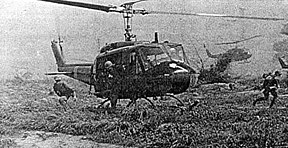 |
MOVE OUT—Golden Dragons from the 2nd Battalion, 14th Infantry leave their choppers and race for cover. |
Of Their Own Fee Choice
. . . and to create an elected government
The vast majority of the people of South Vietnam are determined to build
their own future under institutions of their own free choice.
In the Declaration of Honolulu on Feb. 8, 1966, the government of Vietnam
pledged "to formulate a democratic constitution . . . including an electoral law . .
. and to create, on the basis of elections rooted in that constitution, an elected
government."
The people have refused to be deterred by Viet Cong terrorism and upheaval of
conflict.
Six times in two years, South Vietnam has taken major steps toward
establishing a government fully responsive to the people. In May, 1965, nationwide
elections were held for provincial and municipal councils. On September 11, 1966, a
Constituent Assembly was elected to draft a new constitution.
Then, on April 1,1967, the new constitution went into effect. National
elections were held for President and Vice President and the Upper House (Senate) of the
National Assembly in September of 1967.
The Lower House was elected in October and by the end of that month, the new
President and Vice President and government assumed full responsibilities under the new
constitution.
Additionally, local village and hamlet official elections have been going on
since April of 1967. Despite mining, mortaring, assassination and attempts to destroy
registration cards by the Viet Cong, the people remain as resolute about voting as in l954
when one million people decided to leave the North Vietnamese under Geneva agreements.
It is not easy for people to become active supporters of the government when
they have been intimidated and terrorized by the Viet Cong for years and when no
government has been able to adequately protect them and enhance their well-being.
When the province level elections were conducted in 1965, 1,000 candidates
contested for 471 seats. Of the 4.7 million registered voters, 3.5 million or 74% voted.
The major organized labor confederation elected 13 of its 16 candidates and in central
provinces, candidates associated with Buddhist organizations made strong showings.
In 1966, after pledging at the Manila Conference to strengthen the democratic
progress by holding village and hamlet elections, the government issued a series of
decrees completely revising the structure and functioning of local governments. They
provided for popularly elected village councils, which choose village chiefs and popularly
elected hamlet chiefs with elected deputies in hamlets with over 3,000 residents.
The chiefs received new powers, among them a great part in the
decentralization of levying, collection and spending of taxes. Elections took place in
1984 of the 2,526 villages; a 78% turnout indicated the popular support.
On June 19, 1966, the government decreed that elections would be held for 117
deputies to the Constituent Assembly and each seat and the Viet Cong waged a huge
propaganda campaign of intimidation right up to election day. They attacked communication
lines, blew up voter laden trucks, mined bridges, detonated grenades at voting places and
fired at district headquarters during the period.
Some 4.3 million voters voted, 81% of the registered voters and more than 50%
of South Vietnam's 8.25 million population. This proved false the Viet Cong claims to
control over two-thirds of the population and to be sole representative of the Vietnamese
people.
After 170 days, the assembly unanimously approved a revised draft of the
proposed constitution. Upon approval by the Armed Forces Council on March 27 Chief of
State Thieu put it into effect on April 1, 1967.
The main form of government is a modified presidential system. A President is
Chief of State who designates a Prime Minister and a Cabinet to manage government
business. A bicameral National Assembly and an independent Judiciary exercise legislative
and judicial powers respectively.
The Assembly can override a Presidential veto of a bill by an absolute
majority of the total membership of both houses. It can also recommend Presidential
removal of any Cabinet Ministers, including the Prime Minister by a two-thirds total
majority. The Constitution also contains important provisions for protection of human
rights and advancement of social welfare.
On September 3, 1967, the South Vietnamese people went to the polls again to
elect a President and Upper House of the National Assembly. Once again the Viet Cong
terror and intimidation was applied. Some 5.8 million registered voters appeared at the
polls, a half million more than the year before. The figure comprised 57% of the entire
voting age population.
The slate of Chief of State Thieu and Prime Minister Ky received 35% of the
vote and that. Of lawyer Truong Dinh Dzu received second place with 17%.
On October 22, the Vietnamese democratic election was completed. One hundred
and thirty five men and two women were elected to the Lower House of the new National
Assembly. This membership is widely representative of both national and local political
interests as its members come from local constituancies.
The transition from military rule of constitutional democracy without
bloodshed and in the midst of conflict is an unprecedented achievement in rapid political
evolution.
South Vietnam is now beginning a new phase of history, one filled with
promise and problems. The government is untested but resolved to continue the democracy
building process.
(Extracted from MACV Fact Sheet on political development in Vietnam)
Page 11 TROPIC LIGHTNING NEWS Orientation Edition
INFANTRY AND ARTILLERY BATTALIONS
| 3d Squadron 4th Cavalry Nickname: MacKensies Raiders Motto: Prepared and Loyal Organized 17 June, 1855 at Jefferson Barracks, Missouri. Assigned to the 25th Infantry Division 15 February, 1957. Participated in 56 campaigns during the Indian Wars, Civil War, Philippine Insurrection, World War II and Korean War. Has six battle streamers from World War II and Korean War. |
1st Battalion
5th Infantry (Mech.) Nickname: Bobcats Motto: I’ll Try Sir Organized in May or June, 1808 in New England. Assigned to the 25th Infantry division 1 February, 1963. Participated in 36 campaigns during the War of 1812, Indian Wars, Civil War, Mexican War, Philippine Insurrection, World War II and Korean War. Has five battle streamers from the Korean War. |
4th Battalion 9th
Infantry Nickname: Manchus Motto: Keep Up The Fire Organized 17 March, 1855 at Fort Monroe, Virginia. Assigned to the 25th Infantry Division 30 January, 1966. Participated in 45 campaigns during the Indian Wars, Civil War, War With Spain, China Relief Expedition, Philippine Insurrection, World War I, World War II and Korean War. Has 11 battle streamers from World Wars I and II and Korean War. |
||
| 2d Battalion 12th
Infantry Nickname: White Warriors Motto: Led By Love Of Country Organized 20 October, 1861 at Fort Hamilton, New York. Assigned to the 25th Infantry Division 1 August, 1967. Participated in 24 campaigns during the Civil War, Indian Wars, War With Spain, Philippine Insurrection and World War II. Has one battle streamer from World War II. |
2d Battalion 14th
Infantry Nickname: Golden Dragons Motto: The Right Of The Line Organized 8 July, 1861 at Fort Trumbull, Connecticut. Assigned to the 25th Infantry Division 1 August, 1951 to 1 February, 1957 and 21 June, 1963 to present. Participated in 31 campaigns during the Civil War, Indian Wars, War With Spain, China Relief Expedition, Philippine Insurrection, World War II and Korean War. Has one battle streamer from the Korean War. |
2d Battalion 22d Infantry
(Mech.) Nickname: Regulars Motto: Deeds Not Words Organized in May, 1865, at Camp Dennison, Ohio. Assigned to the 25th Infantry Division 1 August, 1967. Participated in 17 campaigns during the Indian Wars, War With Spain, Philippine Insurrection and World War II. Has three battle streamers from World War II. Presently composed of Headquarters Company, three Mechanized Infantry Companies and one Support Company. |
||
| 3d Battalion 22d Infantry Nickname: Regulars Motto: Deeds Not Words Organized in July, 1865 at Camp Dennison, Ohio. Assigned to the 25th Infantry Division 1 August, 1967. Participated in 18 campaigns during the Indian Wars, War With Spain, Philippine Insurrection and World War II. Has three battle streamers from World War II. Presently composed of Headquarters Company and four straight-leg Companies. |
4th Battalion 23d
Infantry (Mech.) Nickname: Tomahawks Motto: We Serve Organized 8 July, 1861, at Fort Trumbull, Connecticut. Assigned to the 25th Infantry Di-vision, 30 January, 1966. Participated in 42 campaigns during the Civil War, Indian Wars, War With Spain, Philippine Insurrection, World War I, World War II and Korean War. Has 14 streamers from World Wars I and II and Korean War. Presently composed of Headquarters Company, three Mechanized Infantry Companies and one Support Company. |
1st Battalion
27th Infantry Nickname: Wolfhounds Motto: No Fear on Earth Organized March 6, 1901 at Fort McPherson, Georgia. Assigned to the 25th Infantry Division February 1, 1957. Participated in 17 campaigns during the Philippine Insurrection, World War II and Korean War. Has six battle streamers from World War II and Korean War. |
||
| 2d Battalion 27th
Infantry Niekname: Wolfllounds Motto: No Fear on Earth Organized March 18,1901 at Fort McPherson, Georgia. Assigned to the 25th Infantry Division August 26, 1941 to February 1, 1957 and June 21, 1963 to the present. Participated in 17 campaigns during the Philippine Insurrection, World War I, World War II and Korean War. Has seven battle streamers from World War II and Korean War. |
2d Battalion 34th
Armor Nickname: Dreadnoughts Motto: Dreadnought Organized October 1, 1941 at Fort Knox, Kentucky. Assigned to the 25th Infantry Division August 1, 1967. Participated in five campaigns during World War II, earning two battle streamers. |
3d Battalion 13th
Artillery Nickname: The Clan Motto: Without Fear, Favor, or in the Hope of Reward Organized June 1, 1917 at Camp Stewart, El Paso, Texas. Assigned to 25th Infantry Division April 1, 1960. Participated in 18 campaigns during World War I, World War II and Korean War. Has four battle streamers from World War II and Korean War. |
||
| 2d Battalion 77th
Artillery Nickname: None Motto: On Guard Organized June 11, 1917 at Fort Ethan Allen, Vermont. Participated in 15 campaigns during World Wars I and II. |
Page 12 TROPIC LIGHTNING NEWS Orientation Edition
Area of Operations
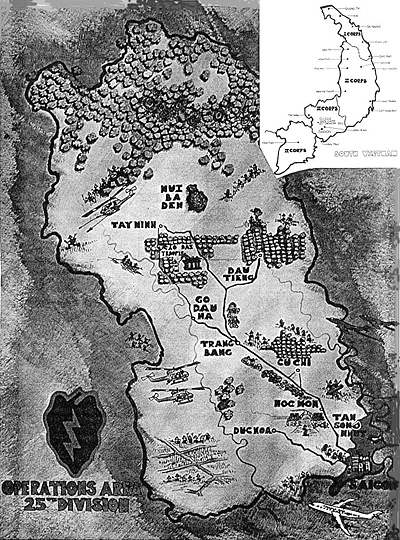
Thanks to
Ron Leonard, 25th Aviation Battalion for sharing
this issue,
Kirk Ramsey, 2nd Bn., 14th Inf. for creating this
page.
This page last modified 8-12-2004
©2004 25th Infantry Division Association. All rights reserved.